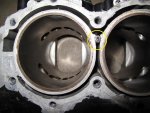1990 Force 50 508F90D
I have seen a lot of questions regarding over heating of outboards, now I have question that I have never seen before. In aquiring a 1990 Force 50 motor that had been over heated, I removed the cyl head. there was a plastic fitting right in front of the thermostat housing that went to a rubber hose, that went up to a water pressure gauge, this had melted, and part of the hose that was close to the head melted also, and the thermostat had melted the wax plug that actuates it. but I noticed on the left side of the thermostat, in the water jacket that surrounds the upper cylinder wall, there is a little rubber seal? that extends parallel to the cylinder axis from the head gasket, to the bottom of the water jacket. this looks as if it effectively forms a dam so that the water has to travel all the way to the bottom of the water jacket channel, and back to the top before it can go out the discharge galley. this little rubber seal, about as big around as a pencil and 3" long fit into a little u channel that was molded into the aluminum? block/water galley. this rubber piece had melted and deformed. Now I have not been able to find this rubber part in any of the pics or diagrams I have looked at, the model no is Force 508F90D. I suppose that this is a very important part, and probably partly why so many people have cooling problems with these outboards.
So my question is, do I really need it, and where can I get it? if it cannot be found could I use a little piece of heater hose and cram it in there to do the job?
thank you in advance for your time
I have seen a lot of questions regarding over heating of outboards, now I have question that I have never seen before. In aquiring a 1990 Force 50 motor that had been over heated, I removed the cyl head. there was a plastic fitting right in front of the thermostat housing that went to a rubber hose, that went up to a water pressure gauge, this had melted, and part of the hose that was close to the head melted also, and the thermostat had melted the wax plug that actuates it. but I noticed on the left side of the thermostat, in the water jacket that surrounds the upper cylinder wall, there is a little rubber seal? that extends parallel to the cylinder axis from the head gasket, to the bottom of the water jacket. this looks as if it effectively forms a dam so that the water has to travel all the way to the bottom of the water jacket channel, and back to the top before it can go out the discharge galley. this little rubber seal, about as big around as a pencil and 3" long fit into a little u channel that was molded into the aluminum? block/water galley. this rubber piece had melted and deformed. Now I have not been able to find this rubber part in any of the pics or diagrams I have looked at, the model no is Force 508F90D. I suppose that this is a very important part, and probably partly why so many people have cooling problems with these outboards.
So my question is, do I really need it, and where can I get it? if it cannot be found could I use a little piece of heater hose and cram it in there to do the job?
thank you in advance for your time




















